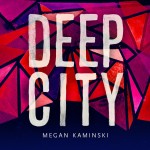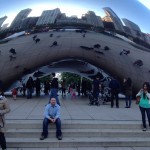
Deep City by Megan Kaminski
a review by Dale Enggass
Noemi Press
2015
Underground Alphabets
“There are no cities, no cities to love” proclaim Sleater-Kinney on their latest LP, but I guess they can be forgiven for not anticipating Megan Kaminski’s new book of poetry Deep City, a collection so attuned to the pleasures of sound and perception that one can’t help loving its intricate architecture. Kaminski has a wonderful sense of the line as unit, and a finely calibrated sense of how words hang together in sound, viz.:
I watch the sun drag
skimming the shoreline in winter months (36)
where “drag,” perched precariously between transitive and intransitive, is both doubled and undone by “skimming.” Surface and depth slide over each other: the lightness conjured by the pairing of “sun” and “skim” (so close to “skin”) is darkened by the unsettling implications of “drag” (to drag a body of water, for example). But in the next line, before one is pulled too far in this direction, “winter months” sheds two letters to become “white moths,” returning us to the light, fluttering quality of “skimming.”
Which is to say, these are certainly not poems to be skimmed. They reveal their hidden resonances slowly, like an unfamiliar neighborhood does for one committed to wandering its side streets. The City of Deep City is not one but many: London, New York, Paris, Rome, Warsaw, Los Angeles among others. The speaker(s) of these poems literally and figuratively slips into and out of these locations; as Kaminski writes, paraphrasing Young Jeezy, “I put on my city” (15). The same poem, from the opening section titled “The Cities,” illuminates the bodily and linguistic nature of the speaker’s becoming-city. It is worth offering in full:
Vowels roll drip down thighs
conjunctions across backs
ankles necks
secret places
silk feathers curling horns
gold chains old rags smelling of animal
I put on my city
buildings cafes shops
soft text keening
through silence and explosion
through parts of throbbing
city built line on line body on body
alphabet buried beneath street
concrete-riverbed-city
cross-sectioned-fluid-fattened (15)
Nouns accumulate (“buildings cafes shops”; “concrete-riverbed-city”) precisely without “conjunctions,” and Kaminski’s deft modulation of pacing and syntax captures the often-erotic energy of the urban. The repetition of “through” suggests the conflation of text and architecture as it reminds us of the multiple senses of “passage”: an excerpt of text; a space connecting buildings; a process of transition; a walk (passage, from Latin passus or “pace”; “to stretch the legs” (New Oxford American Dictionary)). The city as garment, as text, to be experienced first and foremost through the body, is the impetus for these poems. They seek new associations, new assemblages, and a new or at least renewed grammar of the city and its accumulation of humans and capital.
Thus the poem recalls, while critically altering, the famous Situationist graffito “Beneath the street, the beach!” (“alphabet buried beneath street”). Beneath Kaminski’s streets lies a language of tunnels, pathways, “secret places.” This is the feral city, and, as the book’s title indicates, the infra-city, the city below the rational grid. Throughout, Kaminski registers this rejection of rational space formally on the page, nowhere more so than in the final section, titled “Collection.” Here, the majority of the poems appear split between minimalist two-word lines (generally a noun and an adjective) and seven or eight-line stanzas, which between them weave a web of puns and connotations that occasionally reminded me of Harryette Mullen’s complex wordplay. The poems in “Collection” combine list with lyric in an unresolved tension that requires multiple reading strategies and rewards repeated forays into its “drifting methodical downtown denser traffic” (69).
These poems drift amidst the peripheral, discovering sites that force us to be still and pay attention, much as Kaminksi’s precision and facility with sound is frequently arresting, as in the line “airshafts draw eyes to peripheries of high-rises” (42). A quotidian view (one imagines those non-descript apartment blocks that ring European cities) is transformed into one full of strange potential through the way the upward movement of sight is registered in the vowel shift from a to ô to I. Such meticulous construction is what makes these poems a pleasure to explore. So, let their architecture of “minimalist metal and earthy stone” (39) sharpen your eyes and mind, and if your surroundings become unfamiliar–so much the better.
